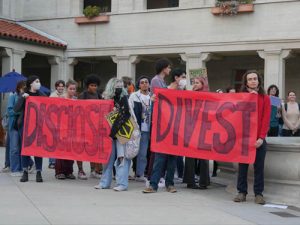Where Will Your Campus Endowment Go in the Future?
 Divestment is a hot topic in today’s social, political, and economic climate. Among RCC Fellows, and many environmental activists across college campuses, divestment is best known as a strategy to denounce and delegitimize the fossil fuel industry (among others) through dissolution of fossil fuel assets in an institution’s endowment. But an important component of divestment — and less frequently mentioned — is the process of reinvestment.
Divestment is a hot topic in today’s social, political, and economic climate. Among RCC Fellows, and many environmental activists across college campuses, divestment is best known as a strategy to denounce and delegitimize the fossil fuel industry (among others) through dissolution of fossil fuel assets in an institution’s endowment. But an important component of divestment — and less frequently mentioned — is the process of reinvestment.
When advocating for divestment campaigns, it is essential to consider how an institution reinvests its funds: a plan for reinvestment should be developed as a core part of future investment policy and fiduciary responsibility. Frequently, this is considered the next step to be implemented after a divestment campaign; I consider reinvestment and sustainable investment to be essential, ongoing parts of any divestment campaign as they hold an institution accountable to divestment goals in the long-term.
 The Rachel Carson Council’s comprehensive report, “Money Talks: Strategy, Success, and Action on Divesting and Reinvesting Funds for Fossil Fuels,” gives a detailed breakdown of fundamental components of divestment campaigns. The section “Sustainable Investing” provides insight into four possible sectors of reinvestment that student activists can incorporate into the reinvestment strategy for their institutions: socially responsible investing, impact investing, environmental social governance (ESG) investing, and renewable energy investing.
The Rachel Carson Council’s comprehensive report, “Money Talks: Strategy, Success, and Action on Divesting and Reinvesting Funds for Fossil Fuels,” gives a detailed breakdown of fundamental components of divestment campaigns. The section “Sustainable Investing” provides insight into four possible sectors of reinvestment that student activists can incorporate into the reinvestment strategy for their institutions: socially responsible investing, impact investing, environmental social governance (ESG) investing, and renewable energy investing.
The importance of building a reinvestment framework and plan for your institution’s endowment is manifold. First, consider the successful scenario where an institution commits to divesting from companies in the fossil fuel industry — without a plan, the institution may reinvest their endowment in sectors that cause other considerable forms of environmental or social harm. It is important for divestment demands to include a comprehensive framework on responsible investment, and for this framework to be a fundamental part of the advocacy and negotiation process. Even in the case where a college commits to ESG investment or socially responsible investment, these methods are notorious for their lack of standardization and governance. It is up to every individual investor or fund to create their own ESG or socially responsible investment framework; thus, it lacks concrete definition and is likely to not be aligned with divestment goals.
 Otherwise, consider the more common scenario where an institution is hesitant, or averse, to fossil fuel divestment. This is the limbo space in which my college — Pomona College — and our student divestment campaign have been working for a decade. The movement has stagnated from setbacks and blocks from the school administration, COVID-19, and activist burnout — to name a few — leading me and other organizers to continually seek different pathways to push for divestment through collaboration with other student activist groups, student government, and even pre-professional clubs involved with the sustainable space. This has revealed the strategic benefit of developing a reinvestment campaign as another angle — perhaps even “administration aligned,” — to take in our overall divest movement.
Otherwise, consider the more common scenario where an institution is hesitant, or averse, to fossil fuel divestment. This is the limbo space in which my college — Pomona College — and our student divestment campaign have been working for a decade. The movement has stagnated from setbacks and blocks from the school administration, COVID-19, and activist burnout — to name a few — leading me and other organizers to continually seek different pathways to push for divestment through collaboration with other student activist groups, student government, and even pre-professional clubs involved with the sustainable space. This has revealed the strategic benefit of developing a reinvestment campaign as another angle — perhaps even “administration aligned,” — to take in our overall divest movement.
Over the past few months of my RCC fellowship, in order to develop a more strategic plan for achieving fossil fuel divestment at Pomona, I have been researching the endowment investment frameworks of different colleges within the United States, the field of sustainable investment, and different methods student activists have taken to drive their divestment and reinvestment goals, Yale University’s Advisory Committee on Investor Responsibility, for instance, tasks selected students, faculty, staff, and alumni to make socially responsible recommendations for voting on endowment stocks; Harvard University integrates ESG considerations into all their investments and has committed to net-zero GHG emissions for their endowment portfolio by 2050; Wesleyan University has developed a student, faculty, staff, and alumni panel to advise their Board of Trustees on ethical matters related to their endowment; Massachusetts Institute of Technology publishes their ESG investment framework; and Stanford University has developed a community proposal initiative for comments on the institution’s Statement of Investment Responsibility.
Certainly, all these institutions have different areas for re-evaluation and improvement in divestment matters; however, each institution provides an important, existing model for me to assess in my process of conceiving an investment framework for Pomona College — and better yet, act as a leverage point for reinvestment advocacy, particularly one where student activists can continue to have involvement in endowment matters before and after our divestment goals have been met. Ultimately, the pathway for divestment and campus environmental activism is broad and varied, but taking initiative and moving to the forefront in a process for endowment reinvestment is key. It enables campus activists to better understand long-term divestment goals, and, possibly, become directly involved with an administration’s divestment and reinvestment of its endowment. That is what I hope to be able to achieve at Pomona.
— Selene Li, RCC Fellow
 RCC Fellow Selene Li is working to facilitate Pomona College’s transition to 100% renewable energy and advance the renewable energy infrastructure and requirements on campus. They sit on Pomona’s Carbon Neutrality by 2030 committee and the Board of Trustees Facilities and Environment Committee. Selene hopes to leverage these positions in addition to mobilizing student, faculty, and staff support and interest to achieve these goals.
RCC Fellow Selene Li is working to facilitate Pomona College’s transition to 100% renewable energy and advance the renewable energy infrastructure and requirements on campus. They sit on Pomona’s Carbon Neutrality by 2030 committee and the Board of Trustees Facilities and Environment Committee. Selene hopes to leverage these positions in addition to mobilizing student, faculty, and staff support and interest to achieve these goals.
![]() The Rachel Carson Council depends on tax-deductible gifts from concerned individuals like you. Please help if you can.
The Rachel Carson Council depends on tax-deductible gifts from concerned individuals like you. Please help if you can.
![]() Sign up here to receive the RCC E-News and other RCC newsletters, information and alerts.
Sign up here to receive the RCC E-News and other RCC newsletters, information and alerts.






